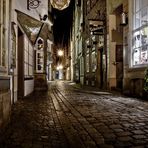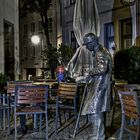the old man

silent road
Paulo Pereira
"Schnoor" in Bremen
Der Schnoor (auch Schnoorviertel genannt; von niederdeutsch Schnoor, Snoor = Schnur) ist ein mittelalterliches Gängeviertel in der Altstadt Bremens. Das Quartier verdankt seine Bezeichnung dem alten Schiffshandwerk. Die Gänge zwischen den Häusern standen oft in Zusammenhang mit Berufen oder Gegenständen: So gab es einen Bereich, in welchem Seile und Taue hergestellt wurden (Schnur = Schnoor), und einen benachbarten Bereich, in dem Draht und Ankerketten gefertigt wurden (Wieren = Draht).
Die erste bekannte schriftliche Erwähnung des Schnoors geht auf das 13. Jahrhundert zurück. Zu dieser Zeit wurde am Rande des heutigen Schnoorviertels ein Franziskanerkloster gebaut, von dem nur die Klosterkirche erhalten ist. Die heutige katholische St.-Johannis-Kirche wurde zwischen 1230 und 1240 im Stil der Backsteingotik als turmlose Hallenkirche mit Dachreiter erbaut.
Zahlreiche Häuser aus dem 17. und 18. Jahrhundert sind noch erhalten und vermitteln einen romantischen Eindruck vom Leben in früheren Zeiten. Viele Straßenbezeichnungen stehen im Zusammenhang mit früheren Nutzungen. So war am Stavendamm die erste öffentliche Badestube zu finden (Stave ist Plattdeutsch für „Stube“), die auch Gelegenheit zu anderen Formen von Vergnügungen bot. Es wird sogar berichtet, dass der Bischof von Bremen durch einen unterirdischen Gang vom Dom bis zum Stavendamm heimlich die Badestube besuchte. Die Legende berichtet, dieser unterirdische Gang habe im noch heute erhaltenen Schifferhaus geendet.
==========================================================
Schnoor is the name of a street in the oldest part of the city of Bremen and also a name for the oldest quarter itself.
Here are the roots of the Hanseatic city Bremen. The quarter Schnoor was the economical centre since early history. Fishermen, craftsmen and traders were the first Bremers and settled in the 10th century, searching the proximity of the river. They built thatched cottages on the little tiny island between the rivers Weser and Balge. It is said that the Weser formerly was a side branch of the Balge.
The first ferry service was installed here, and the first bridge crossing the Weser was built around the year 1240. You can find an old wall and parts of a round tower which was erected around 1200 near the so called Marterburg.
In the 13th century the Franciscan monks had settled and their St. John's church was constructed in the following decades. Today the oldest houses date back to the 15th century, most of them are from the 17th and 18th century.










Creativo Zorton 03/03/2010 20:25
FELICIDADES !Buen trabajo.
CONTRALUZ 1
Creativo ZortonCasa Río Guadiana 1
Creativo ZortonMatthias Besant 01/03/2010 23:27 Commento di voto
proFelipe Riquelme 01/03/2010 23:27 Commento di voto
PRO+++++guvo4 01/03/2010 23:27 Commento di voto
~~pro~~Trixi Schneider 01/03/2010 23:27 Commento di voto
+Nena 01/03/2010 23:27 Commento di voto
pro† Giovanni Pinna 01/03/2010 23:27 Commento di voto
+Ana Iglesias 01/03/2010 23:27 Commento di voto
+++++++++Inez Correia Marques 01/03/2010 23:27 Commento di voto
Proinoxbany 01/03/2010 23:27 Commento di voto
PRO+++++++++++Cécile Fischer 01/03/2010 23:27 Commento di voto
P R OGuglielmo Rispoli 01/03/2010 23:27 Commento di voto
PRO & PROSchnuckenhexe 01/03/2010 23:27 Commento di voto
PRO† Carlos Valcarcel 01/03/2010 23:27 Commento di voto
Es ist die Wirkung in einer Deluxe Edition erreicht. Die ausgezeichnete Farbe. Perfektes Bild.+++
af.foto 01/03/2010 23:27 Commento di voto
++